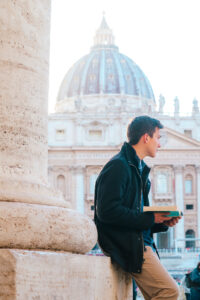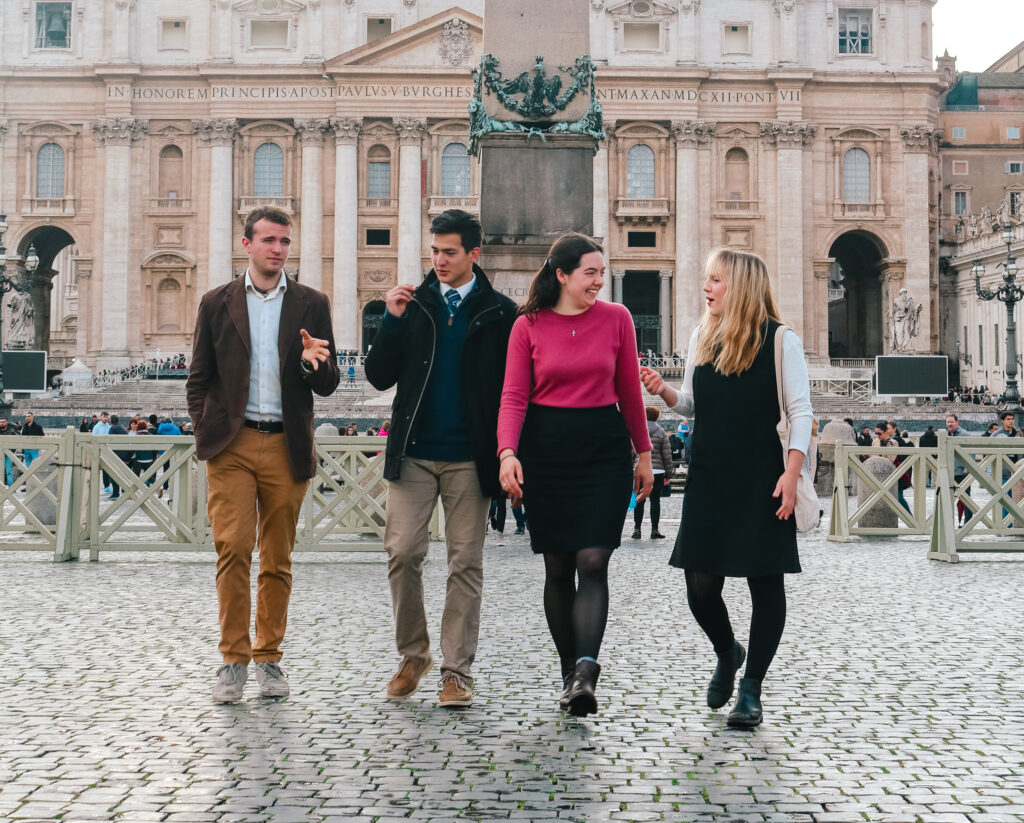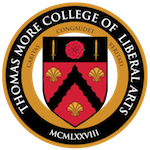An Integral Part of the TMC Experience
“Rome!” The pilgrims took up the cry and repeated, “Roma, Roma!” Then I knew that I was not in a dream, but truly I was in Rome.
—St. Thérèse of Lisieux
Catholic liberal arts education is the study of God and man, and of God made man. Students are called to learn from and love the works of man—especially those made for the glory of God. It is fitting then that Thomas More College students should spend a whole academic term in one of the world’s great cities—the site of the empire that shaped Western history, and the seat of the universal Church.
In their Rome semester, Thomas More College Sophomores traverse catacombs and cloisters, piazzas and palazzos, exploring the heart of the Christian West. The history of Christendom is written in the stones and on the ceilings, in the streets and the cemeteries, and the skyline is dominated not by skyscrapers but by the dome of St. Peter’s.
 Through most of Rome, every 500 yards or so there stands an exquisite chapel or church—one perhaps designed by Bernini, or Borromini, ornamented with art that ranges from ancient mosaics to high Baroque altarpieces, from Renaissance frescos to affectionate memorials of Padre Pio, festooned with plastic flowers. Each day, Rome Program Director and Fellow Paul Connell ’85 leads the student body on explorations that are focused on theology, art, and architecture.
Through most of Rome, every 500 yards or so there stands an exquisite chapel or church—one perhaps designed by Bernini, or Borromini, ornamented with art that ranges from ancient mosaics to high Baroque altarpieces, from Renaissance frescos to affectionate memorials of Padre Pio, festooned with plastic flowers. Each day, Rome Program Director and Fellow Paul Connell ’85 leads the student body on explorations that are focused on theology, art, and architecture.
The Rome semester immerses students in the details of ancient, medieval, and Renaissance art, and the history and teachings of the Church. Students also explore Renaissance churches in Florence and Orvieto, visiting the cave of St. Benedict in Subiaco, the eerie Etruscan tombs at Cerveteri, and the city of St. Francis, Assisi.

Many venture outside the classroom, gallery, and basilica to engage in the one of the Church’s most critical apostolates—communications. In Rome, Thomas More sophomores are invited to take part in internships, such as that offered by the College’s Vatican Studies Center with the Internet-based Catholic media agency, H2o News. Thomas More College students help create TV broadcasts about Church news that are sent around the world—editing copy, correcting translations, and dubbing the voices of newsmakers, cardinals, and even the Pope. Others take advantage of Vatican Studies events to meet with the staff of L’Osservatore Romano, Vatican Radio, and the Congregation of the Doctrine of the Faith.
Masses at St. Peter’s Basilica
TMC students in Rome regularly attend Mass with Pope Francis. In the Spring semester, students attend Holy Week liturgies at St. Peter’s Basilica—including the Chrism Mass, the Good Friday liturgy, and the Holy Saturday Vigil Mass. An ancient tradition in Rome includes attending station masses with the Holy Father at traditional sites throughout the city as well as Stations of the Cross at the Colosseum and Ash Wednesday Mass on the Aventine Hill. These experiences and others help the students to develop a deep and personal love for the traditions of the Church and an attachment to the office and the person of the pope.
Eligibility
The Rome semester is offered in the spring, and all full-time Sophomores participate.
Cost
Room and board is the same price as at the Merrimack campus. Only transportation costs and museum admissions are extra.
Curriculum
Course schedules and class assignments are consistent with the policies of the Merrimack campus. In addition, students take a special course on the art and architecture of Rome—conducted in the churches, museums, and historic sites of the city.

Rome Courses
(4 credits)
This class allows sophomores during their Rome semester intensively to study authors and works from a variety of periods that deepen their experience of Roman, Italian, and European culture. Texts and authors include Virgil, Livy, the Roman poets, St. Francis of Assisi, Dante, Shakespeare, Nathaniel Hawthorne, Hilaire Belloc, Ezra Pound, and Romano Guardini.
(3 credits)
An introduction to the patrimony of ancient and Christian art and architecture, with extensive site visits in Rome, Lazio, Umbria, and Tuscany. The ‘texts’ will principally be the buildings, sculptures, and paintings themselves, but students will also be asked to reflect upon the nature and purpose of the arts through reading selections from Vitruvius, St. John of Damascus, Abbot Suger, Alberti, Josef Pieper, and John Paul II.
(3 credits)
A careful journey through the writings of St. Paul with the goal of attaining a clear understanding of the mystery of salvation. In addition to the Pauline corpus, students will give serious consideration to the commentaries of the Fathers and St. Thomas Aquinas.
(3 credits)
This class is an intensive examination of the traditional role poetry has played in deepening our understanding of the nature of language. In conjunction with the writing tutorials, this course develops the student’s basic knowledge of figures in language, as well as the means to communicate the tone and dramatic situation of a poem. The whole course explores the way poetry can help us to become attuned to the goodness of reality. Authors and texts include: Aristotle’s Poetics, Robert Penn Warren and Cleanth Brooks, Understanding Poetry, the English poet community in Rome (Keats, etc.), Richard Wilbur, and Robert Frost.
